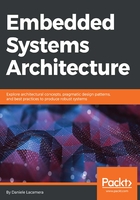
RAM
"640 KB of memory ought to be enough for everyone"
– Bill Gates (founder and former director of Microsoft)
This famous statement has been cited many times in the past three decades to underline the progress in technology and the outstanding achievements of the PC industry. While it may sound like a joke for many software engineers out there, it is still in these figures that embedded programming has to be thought about, more than 30 years after MS-DOS was initially released.
Although most embedded systems are capable of breaking that limit today, especially due to the availability of external DRAM interfaces, the simplest devices that can be programmed in C may have as little as 4 KB of RAM available to implement the entire system logic. Obviously this has to be taken into account when approaching the design of an embedded system, by estimating the amount of memory potentially needed for all the operations that the system has to perform, and the buffers that may be used at any time to communicate with peripherals and nearby devices.
The memory model at the system level is simpler than that of PCs and mobile devices. Memory access is typically done at the physical level, so all the pointers in your code are telling you the physical location of the data they are pointing to. In modern computers, the operating system is responsible for translating physical addresses to a virtual representation of the running tasks. The advantage of the physical-only memory access on those systems that do not have an MMU is the reduced complexity of having to deal with address translations while coding and debugging. On the other hand, some of the features implemented by any modern OS, such as process swapping and dynamically resizing address spaces through memory relocation, become cumbersome and sometimes impossible.
Handling memory is particularly important in embedded systems. Programmers who are used to writing application code expect a certain level of protection to be provided by the underlying OS. In fact, a virtual address space does not allow memory areas to overlap, and the OS can easily detect unauthorized memory accesses and segmentation violations, it then promptly terminates the process and avoids having the whole system compromised. On embedded systems, especially when writing bare-metal code, the boundaries of each address pool must be checked manually. Accidentally modifying a few bits in the wrong memory, or even accessing a different area of memory, may result in a fatal, irrevocable error. The entire system may hang, or, in the worst case, become unpredictable. A safe approach is required when handling memory in embedded systems, in particular when dealing with life-critical devices. Identifying memory errors too late in the development process is complex and often requires more resources than forcing yourself to write safe code and protecting the system from a programmer's mistakes.
Proper memory-handling techniques are explained in Chapter 5, General Purpose Peripherals.